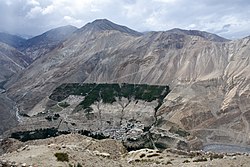Village in Himachal Pradesh, India
| Leo Liyo | |
|---|---|
| village | |
 Leo village, Jun '18 Leo village, Jun '18 | |
 | |
| Coordinates: 32°00′03″N 77°26′15″E / 32.00083°N 77.43750°E / 32.00083; 77.43750 <<< get from OpenStreetMap.org >>> | |
| Country | |
| State | Himachal Pradesh |
| Area | |
| • Total | 2.69 km (1.04 sq mi) |
| Elevation | 2,871 m (9,419 ft) |
| Population | |
| • Total | 784 |
| • Density | 290/km (750/sq mi) |
| Languages | |
| • Official | Hindi |
| Time zone | UTC+5:30 (IST) |
| Website | https://hpkinnaur.nic.in |
Leo (also Liyo, Hindi: लियो ) is a small village in Kinnaur district, Himachal Pradesh, India. The village is situated on a mountain ridge on the right bank of the Spiti River. It is located 116 kilometres (72 mi) from Kaza on NH 505.
The people of Nako are largely agriculturalists. Leo is popular with trekkers.
History
One of the earliest descriptions of Leo is by the botanist Thomas Thomson based on his expedition in August 1847. He trekked from the Sutlej valley over the Hangaranj Pass, then descended via Hango to Leo (Lio). He found a sizeable village with many terraced fields.
Geography

Leo is a small village in Kinnaur District. It is located at a distance of 93 kilometres (58 mi) from the district headquarters Reckong Peo on NH 505. Leo village has an area of 269 hectares (660 acres). Leo is situated on the bank of a small right-bank tributary of the Spiti River. The Spiti River passes through a deep ravine with precipitous mountains on either side. The banks are covered with loose shingle.
Demographics
The population as of the 2011 Census was 784 with 161 households. Females comprise 46.8% of the population. The percentages of Scheduled Castes is 2.0% and of Scheduled Tribes is 87.8%. The literacy rate is 71.6%, with males at 79.9% and females 62.1%.
The languages are Spiti Bhoti and Hindi. The people of Leo are mostly Mongoloid. The main religion followed is Mahayana Buddhism. Leo has a Gram Panchayat.
Amenities
Leo has schools from primary up to senior secondary. The village is served by an India Post Sub-Post Office, with PIN code 172112.
Economy
The economy is largely agrarian. Tourism is also important.
Agriculture
When the botanist Thomson visited Leo (Lio) in August 1847, he found a sizeable village with many terraced fields. Crops grown included wheat, barley, buckwheat and millet. The fields had many apricot trees interspersed with the crops. Thomson speculated that agriculture flourished due to good heat due to reflection from surrounding mountains. He expressed surprised at the complete absence of trees despite the altitude being below the tree line.
Traditionally, up to 1980, five crops were important in Spiti valley, namely black pea, potato, barley (hull-less and covered) and wheat. A study done in 2007–2009, found that by 1990, farmers had diversified to 9 crops. One of the new crops, green peas, covered about 47% of the survey area by 2000. Some of the main reasons for adoption of new crops include better road connectivity and transport to reach markets, declining demand for traditional crops, and availability of hybrid seeds and favourable micro-climatic niches.
Tourism
Leo is located in Kinnaur in the northeast corner of Himachal Pradesh. Bordered by Tibet to the east, Kinnaur is a beautiful district having three high mountains ranges i.e. Zanskar, Greater Himalayas and Dhauladhar, and the enclosing valleys of the rivers Sutlej, Spiti, Baspa and their tributaries. The slopes are covered with thick woods, orchards, fields and picturesque hamlets. The much revered religious Shivlinga lies at the peak of the Kinnaur Kailash mountain.
A popular trek passing through Leo is from Reckong Peo in the Satluj valley to Nako in the Spiti valley. The trek takes 6 days. After a steep climb to the Hango Pass, the trail descends to Leo (Liyo) on the south bank of the Spiti. There, the trail crosses the Spiti river and climbs up to Nako.
Transport
Buses ply from Shimla on NH 5 and NH 505 to Kaza in Spiti via Nako. From Nako, taxis are available to Leo.
See also
References
- "Kaza-Leo route". OpenStreetMap. Retrieved 21 December 2022.
- ^ Thomson, Thomas (1852). "Chapter IV". Western Himalayas and Tibet. London: Reeve and Co.
- "Recong Peo-Leo route". OpenStreetMap. Retrieved 21 December 2022.
- ^ District Census Handbook: Kinnaur, Himachal -- Village and Town Directory. 3 Part XII A. Directorate of Census Operations, Himachal Pradesh, Ministry of Home Affairs, Govt of India. 2011.
- ^ District Census Handbook: Kinnaur, Himachal -- Village and Town wise Primary Census Abstract (PCA). 3 Part XII B. Directorate of Census Operations, Himachal Pradesh, Ministry of Home Affairs, Govt of India. 2011.
- Government of Himachal Pradesh (24 January 2023). "Culture & Heritage: The People". Retrieved 19 June 2023.
- "List of PRIs" (PDF). Panchayati Raj Department, HP Govt. Retrieved 25 January 2021.
- "Village/Locality based Pin mapping as on 16th March 2017". Data.gov.in. Retrieved 25 July 2021.
- Sharma, H.R.; Chauhan, S.K. (2013). "Agricultural Transformation in Trans Himalayan Region of Himachal Pradesh: Cropping Pattern, Technology Adoption and Emerging Challenges" (PDF). Agricultural Economics Research Review. 26 (Conference Number): 173–179.
- Government of Himachal Pradesh (24 January 2023). "About District Kinnaur". Retrieved 28 May 2023.
- Government of Himachal Pradesh (24 January 2023). "Kinnaur: Adventures: Reckong Peo to Nako".
- Government of Himachal Pradesh (24 January 2023). "Kinnaur: How to Reach". Retrieved 28 May 2023.